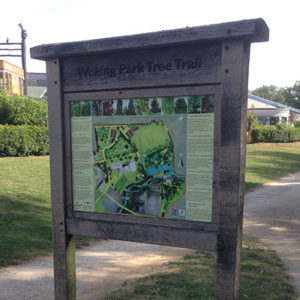
Start
Listed below are the titles and descriptions of the trees which form the Woking Park Tree Trail. The locations of each of the trees can be found on the map near the entrance to the leisure centre and playground. There is a key and each tree is numbered.
Note, the trees themselves are not marked with the numbers on the trail, you will need to find them using the map and your powers of observation.
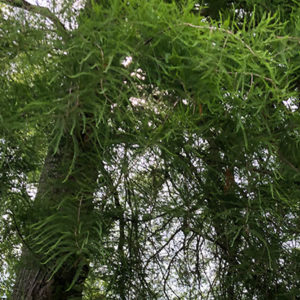
Tree 1: Swamp Cypress (Taxodium distichum)
Native to south east USA, it was once indigenous to Britain. There is evidence of its presence from prehistoric times on the south coast of England. In modern times, it was introduced to Britain in 1640. Thriving where it is wetter and warmer, the roots are often submerged or in waterlogged ground. The needles and shoots of this deciduous conifer are fine and feather-like, turning bright red before they drop. The bark is fibrous, the wood durable and waterproof, commonly used in barrels and window frames.
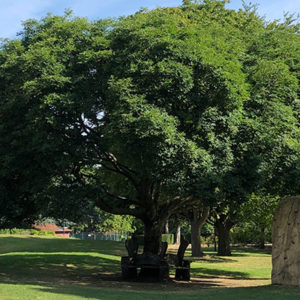
Tree 2: Manna Ash (Fraxinus ornus)
Native to southern Europe and south west Asia, the Manna Ash or flowering Ash has been grown in Britain since circa 1700. A sweet sap, known as manna, is extracted from its stems to make a laxative. It is slow growing, forming a rounded tree with white, fragrant blossoms in late spring. In autumn the pinnate leaves change from yellow to red or orange.
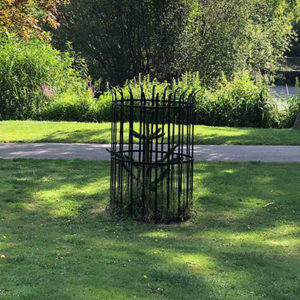
Tree 3: Wellingtonia (Sequoiadendron giganteum)
Introduced to Britain in the early 1890s, it was named after the recently deceased Duke of Wellington. The Wellingtonia is a native of California, growing incredibly large and fast, white living for more than 3,000 years. It holds the distinction of being the largest living tree on Earth. It has soft, dark red bark and frond-like blue-green leaves arranged spiraling around the shoots, forming a dense crown. It also produces cones.
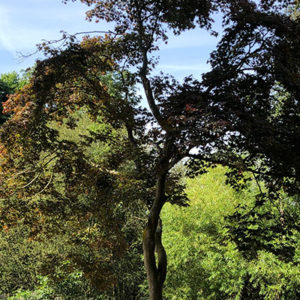
Tree 4: Japanese Maple (Acer palmatum)
Introduced to Britain in the 1820s, it is considered native to both China and Korea. A small tree, it has a rounded habit and its deeply lobed leaves turn shades of yellow, red and orange in autumn. Small red flowers in spring are then followed by winged red or green fruits.
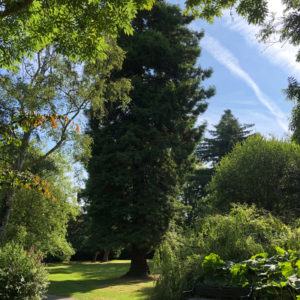
Tree 5: Coastal Redwood (Sequoia sempervirens)
First came to Europe from its native California in 1840. Also known as the California Redwood, it is a a member of the cypress family and is evergreen, forming a narrow conical crown with thick red/brown bark, it also produces cones. In its natural environment it can grow to over 100 metres tall with a stem diameter of over 10 metres, living to over 2,000 years old. However, in the south of England, it is likely to only grow to a height of less than 30m.
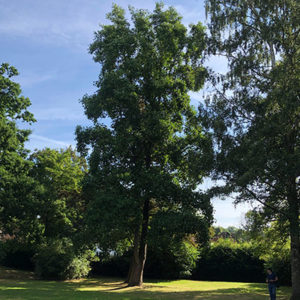
Tree 6: Tulip Tree (Liriodendron tulipifera)
Introduced from its native America in the late 1680s, the timber is widely used in house interiors. A large fast growing tree with a broad, pyramid shaped crown, it has tulip shaped flowers in June and July, which are pale green with a band of orange at the base. Apparently, good quality honey is provided by bees harvesting its flowers. In autumn the leaves turn yellow before falling.
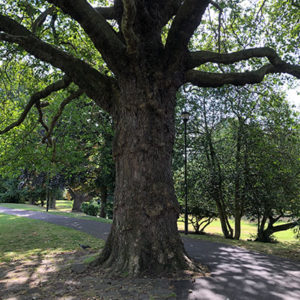
Tree 7: London Plane (Platanus x hispanica)
First recorded in the early 1660s, it was extensively planted as a street tree due to its tolerance of air pollution and pruning. It is understood to be responsible for clearing up the smog-laden air resulting from the industrial revolution. It can be identified by its camouflage bark and bauble hanging fruit in winter. A large, fast growing tree, it has a broadly oval crown with leaves which are large and deeply lobed.

Tree 8: Sweet Gum (Liqiodambar styraciflua)
Introduced from its native eastern USA in the 17th Century, it has an aromatic gum described as “liquid amber” which is used in adhesives and perfumes. Its corky bark is a feature, although the wood is prone to rot. During autumn, its leaves turn purple, orange and yellow and are arranged in pairs. The fruits of the tree are known as ‘monkey balls’ changing from green as they ripen to a spiky brown globe remaining throughout winter.
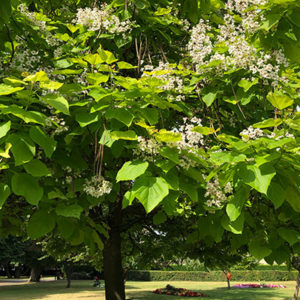
Tree 9: Indian Bean Tree (Catalpa bignonioides)
This tree species comes from south east USA. Introduced to Britain in 1726, it has slim, dark, bean-like pods containing winged seeds, which split in winter to release the seeds. It has heart shaped leaves through June to September. Blossoming in July, it provides orchid-like flowers in large clusters.
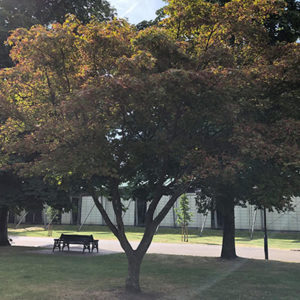
Tree 10: Katsura Tree (Cercidiphyllum japonicum)
The Katsura Tree was introduced to Britain from the Far East in the early 1880s. Native to Japan and China, it is one of the largest deciduous trees in Asia. The leaves are small but provide good colour, pink in spring, bright green in summer and yellow, orange or red in autumn. With the scent of burnt sugar in autumn, it is sometimes referred to as the Candy Floss Tree.
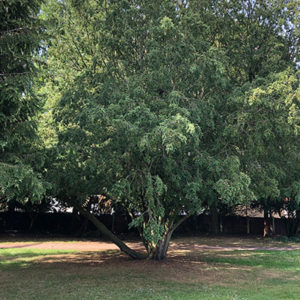
Tree 11: Chilean Plum Yew (Prumnopitys andina)
An attractive Chilean Conifer this is a rare specimen often confused with the European Yew. Found in South Central Andes it is now under threat in its natural environment, it is estimated that perhaps fewer than 10,000 Chilean plum yew trees now remain in their natural range. The green plums are rarely seen in the UK.
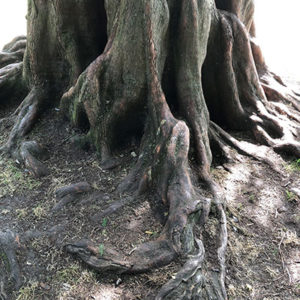
Tree 12: Dawn Redwood (Metasequoia glyptostroboides)
Discovered near the Yangtze River in China in the 1940s, before which it was thought to be extinct. Since its introduction, some specimens have already grown as high as 40 metres. A deciduous conifer, it has a familiar conical shape and produces cones. The leaves are short broad needles turning brown in autumn. Often confused with Swamp Cypress.